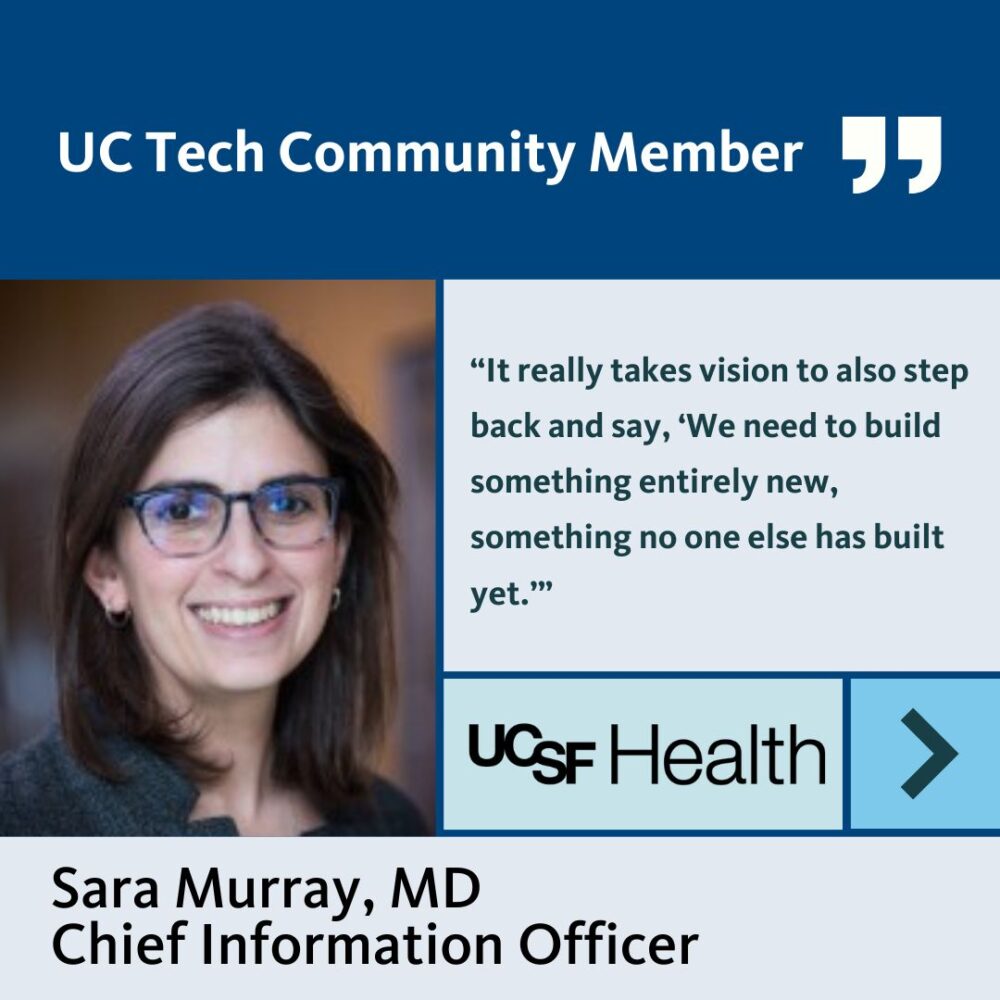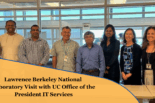Artificial intelligence is reshaping many industries, but few environments are as complex – or as consequential – as healthcare. While in accuracies and hallucinations in AI can be inconvenient, in health care, there is no room for error. At UCSF Health, Dr. Sara Murray, as Chief Health AI Officer, is leading the charge to bring AI into clinical care in ways that are safe, equitable, and effective. Her work is not only transforming UCSF, but also extending UC Health’s innovations to hospitals and communities across California. In this interview, she shares her recent accomplishments, provides context in terms of where AI is – and is not yet – in patient care, and reveals important insights into why UCSF Health is a leader in managing innovation in the AI arena.
Sara Murray: Shaping AI’s health care future
A physician-turned-health services researcher, Murray launched her AI journey during the early days of electronic health record (EHR) adoption at UCSF in 2015. That pivotal moment sparked her interest in using data to improve care delivery. She went on to build UCSF’s Health AI team, a cross-functional group that blends data science, clinical insight, and operational know-how to deliver real-world impact.
The YouTube version of this video, with captions, can be found here.
Highlights of the last decade at UCSF
1. Deploying AI Scribes
Automated note-taking tools free physicians to focus on patients, improving the quality of interaction.
“Providers call this a game changer. Patients say, ‘For the first time, my doctor looked me in the eyes and really talked to me.’”
Results: Reduced physician burnout and higher patient satisfaction.
Read more: How Artificial Intelligence is Fostering Human Connection in Health Care (Feb. 13, 2025)
2. Establishing AI Safety Oversight
UCSF developed the Impact Monitoring Platform for AI in Clinical Care (IMPACC), which continuously tracks deployed AI tools to ensure they remain safe, fair and effective.
Responsible AI doesn’t stop at deployment—”once we deploy these tools, recognizing the ongoing risks, how they change over time, we really have in place the right tools to monitor them effectively and catch things before they potentially cause any problems.”
Results: Ongoing safeguards for safe and fair use of AI in patient care.
Read more: First Continuous AI-Monitoring Platform in Clinical Care (“IMPACC”) (May 29, 2024)
3. Expanding Access to AI Across Community Hospitals
UCSF leads the Health AI Partnership, mentoring safety-net and community hospitals so AI innovation benefits all Californians. Murray noted that eliminating bias in systems is complex, and large institutions such as UCSF can share lessons to help smaller hospitals adopt AI responsibly.
“We are developing strategies to make it easier for smaller hospital safety-net hospitals to deploy AI for meaningful use cases and do it in a safe and effective way.
Results: More equitable AI adoption across California hospitals.
Read more: Health AI Partnership
4. Building Generative AI Infrastructure: Versa Chat
UCSF IT leadership created Versa Chat, a secure, HIPAA-compliant generative AI platform designed for clinical settings. The system supports innovation while protecting patient data.
“Versa has allowed us to start testing clinical use cases which we have been very excited about.”
Results: Streamlined workflows, hundreds of staff hours saved, and automated policy summaries and reporting.
Read more: The UCSF Versa AI Tiger Team Wins the Gold AI Impact Award at the 2025 UC Tech Awards
Why It’s Working: Culture, Collaboration, and Vision
What sets UCSF’s AI efforts apart is not just the tools—it’s the ecosystem. Murray credits the success to:
- A long-term leadership vision and willingness to invest strategically
- Strong partnerships between academics and clinical operations
- A unique combination of collaboration across the clinical and research sides of the organzation
“There are unique things UCSF Health has done in AI, which will position us to be leaders.” She explained that this work has emanated from a strong leadership vision: “Health systems are incredibly complex, with so much happening day to day—keeping operations running, ensuring patients receive the care they need. It really takes vision to also step back and say, ‘We need to build something entirely new, something no one else has built yet.’”
Results: This alignment allows AI innovations to move from prototype to practice, with ongoing feedback loops that support continuous improvement in patient care.
Looking Ahead: The Transformative Power of AI in Medicine – where we are today and where we are headed
Murray provided a realistic picture of where is – and is not yet – today. While AI is being used to transform operations, it is not yet being used to diagnose and treat patients.
AI Capabilities and Limitations in Inpatient Care (\
Where AI stands today, in summary
- AI Scribes reduce physician workload and will soon expand to pre-charting
- UCSF governs AI to ensure ongoing oversight and that a “human” is always in the room.
- UCSF shares insights on Responsible AI implementation with safety-net hospitals across the state
- UCSF VersaChat allows teams to analyze records and run queries in a way that is safe and effective
What AI in Health Care Cannot Yet Do
Murray emphasized that while AI is useful for certain operational and clinical support tasks, it is not yet ready to serve as a standard of care.
- Full Clinical Decision-Making Autonomy: AI can suggest diagnoses or treatments, but it cannot replace physician judgment, accountability, or nuanced decision-making.
- Comprehensive Patient Record Analysis: Summarizing entire medical histories with context remains technically challenging.
- Integration with Complex Workflows: AI scribes are effective in outpatient settings but struggle in inpatient care, where information changes rapidly.
- Reliable, Bias-Free Predictions: Early predictive models displayed bias against underrepresented populations, highlighting the need for caution.
As Murray noted, no AI tool is at the point where not using it would constitute malpractice. AI should remain an optional support tool until consistent improvements in patient outcomes are demonstrated.
Related Reading
- RESOURCE: About AI at UCSF
- July 24, 2025: NEWS: The UCSF Versa AI Tiger Team Wins the Gold AI Impact Award at the 2025 UC Tech Awards
- May 31, 2024: UCSF to build novel continuous AI monitoring platform
- May 29, 2024: First Continuous AI-monitoring Platform in Clinical Care
- March 11, 2024: The Transformative Potential of Clinical AI Rests on a New “Implementation Science”
- December 14, 2023, UCSF Entering 2024 ‘Amazingly Positioned’ to Lead in Health Care AI Revolution







